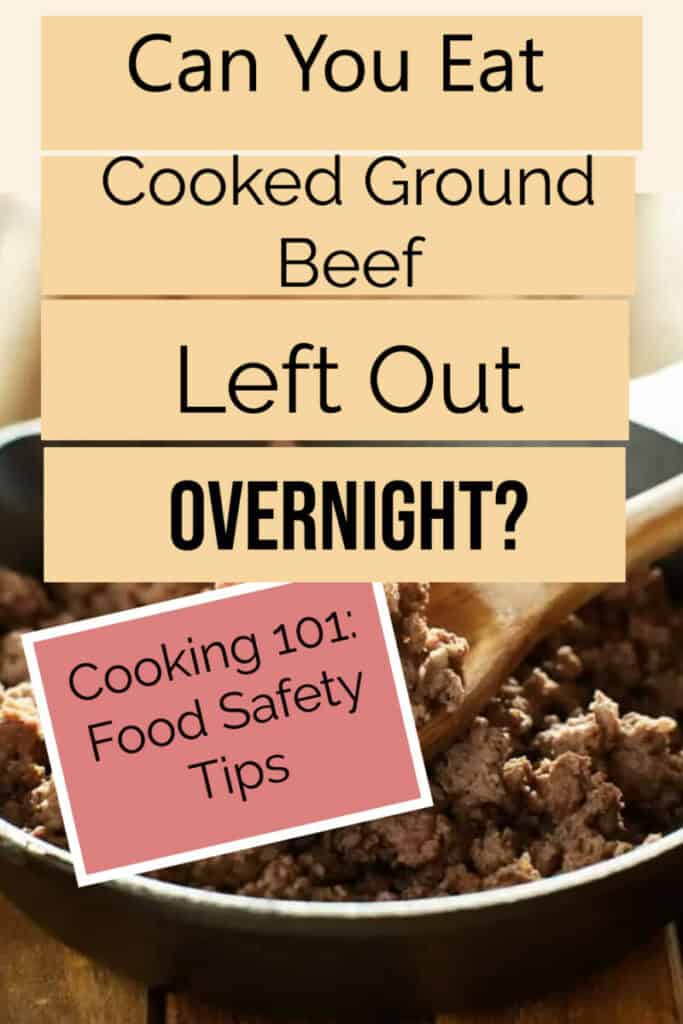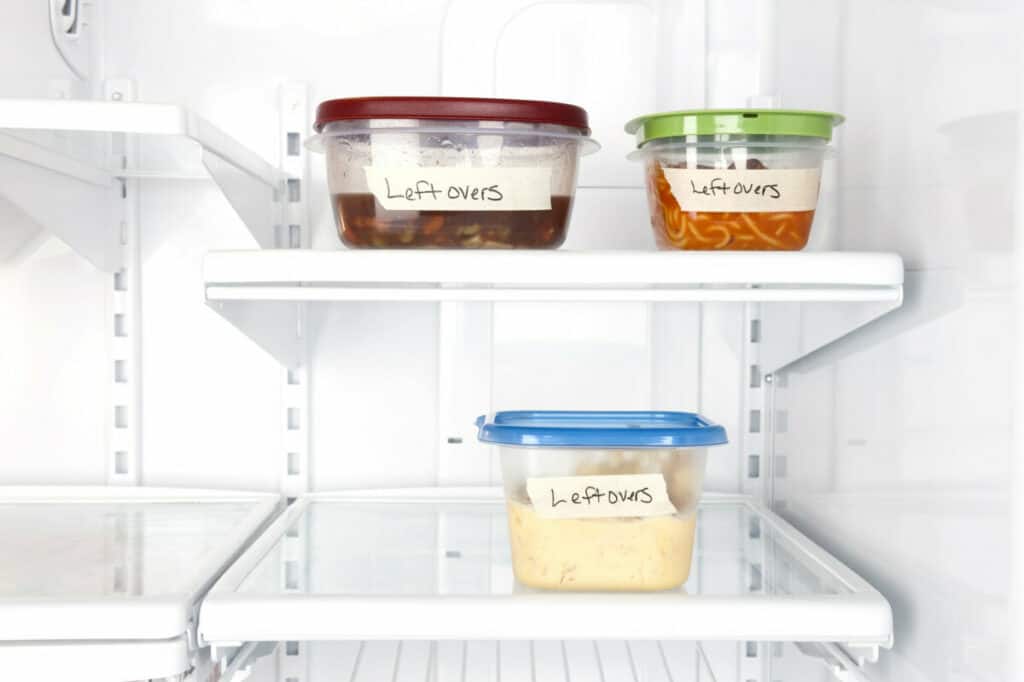This post contains affiliate links.
In the busyness of our day, sometimes putting dinner away can slip our minds at the end of the night. But how long will it last after being left out overnight?
Cooked ground beef is not safe to eat it is left out overnight, even if it still smells and looks like it is safe to eat as it has reached unsafe temperatures. However, if ground beef is only left out for 2-4 hours, it can still be eaten. Always keep cooked ground beef in the fridge or freezer.

However, there are some things that could be done to prevent us from forgetting our taco dinner meat at night and having to throw away the leftovers. If you worry that you won’t remember to take care of the leftovers before that 2-hour mark, there are a few methods to help us prevent that before it happens!
Meat Temperatures
You should always verify meat temperatures to make sure it’s safe to eat. You can do this by using a meat thermometer. Food safety specialists say there’s a “danger zone” in temperature for meat where harmful bacteria will have a chance to grow rapidly. That temperature range is between 40 degrees Fahrenheit and 140 degrees Fahrenheit.
It’s recommended that if you leave food in the “danger zone” for over 2 hours, toss it out as soon as possible. In some cases, when the outside temperature is above 90 degrees Fahrenheit, that time frame should shorten to be an hour at the most.
The best advice would be to keep cold food cold, at or below a temperature of 40 degrees Fahrenheit. And then to keep hot food hot, at or above a temperature of 140 degrees Fahrenheit.
Of course, if you let your meat cool down a bit before storing it in the refrigerator overnight, that’s totally fine. Just make sure you reheat it to the correct temperature before consuming it.
Keeping Meat Cold
If you have uncooked or cooked meat that’s meant to be cold, remember the temperature of the meat shouldn’t rise above 40 degrees Fahrenheit. Room temperature is okay, so long as it’s not left out for longer than the 1 to 2-hour recommendation from food safety specialists.

If it’s going to be used or eaten rather quickly, but not within that 2-hour span of time, it’s recommended to keep it in a resealable bag or container and keep it in the fridge when it is not being actively eaten. It will also keep the food edible for longer than that 2-hour recommendation, up to a few days or more.
If your meat is not going to be used or eaten within a day or so- specifically for uncooked meat- it’s recommended to freeze it and thaw it as you plan to use it. You can also do this with cooked meat to help save some time in the meal prepping process. Again, when you plan to use the cooked meat, it needs to be reheated back to the necessary temperature to ensure proper food safety.
If you are out and about with meat needing to be chilled, keep it in a cooler, in a container with ice in it, or in containers on ice.
Keeping Food at the Right Temperature
After being cooked, meat should typically stay at its regulatory temperature to ensure food safety, especially when cooking. Some meats, especially with certain types of recipes or pre-made/frozen meals, will already have a specific temperature recommended that will always fall under normal food safety regulations. When there is not a recommended temperature, however, typically cooked meat should be at a temperature of at least 140 degrees Fahrenheit or more to be safe for consumption. Ground beef typically needs to be cooked to 165 degrees Fahrenheit before it is safe to eat.
There are some different ways to keep cooked meat at its necessary regulatory temperature. If you cooked it on a stovetop, you can keep a lid on it and the burner on either low or just high enough to keep it warm for the necessary amount of time needed. You could also keep it warm in the oven in an oven-safe container/pan.
Some ovens will also have a section called a “bread warming drawer” that can be used to keep the meat warm as well. You can also use heated chafing dishes, or keep the meat in preheated steam tables, warming trays, or slow cookers.
Always make sure to check the meat temperature with a meat thermometer and that the meat remains at a temperature higher than 140 degrees Fahrenheit. If not, you need to reheat it back up to the necessary temperature before consuming it.
As mentioned before, you may store cooked meat in the fridge or freezer for a duration of time so long as you reheat it to the regulatory temperature for safe consumption. However, if you’ve left it out for a long time (more than 2 hours) at room temperature and its temperature dropped below the recommended temp, you should throw it away instead of trying to save it for a different day.
Ways to Remember to Put Away Your Leftovers
Regulatory temperatures and recommended time frames for leaving meat out are all very helpful to know. However, how are we going to remember to put away the leftovers to prevent our dinner meat from falling into the “danger zone” before it’s too late and we have to throw it out? Well, it would all depend on what works best for you.

Maybe you set an alarm on your phone to get after you to put it away before the 2 hours of recommended time is up. Or, you could try to incorporate it into your end-of-dinner routine. As you take your dirty dishes to be cleaned or put in the sink, simply take the time to put the meat away and then take care of the dishes that were used for cooking as well. Or, if you are a checklist person and like to check things off a list each day for a daily routine, add it to the checklist to do shortly after you finish eating!
If you have young kids and each child has a specific chore to do, or the chore routine switches every day or every week, add putting the dinner meat away to the chore list can help it to get done as well! With younger kids, it would probably be recommended that a parent, guardian, or an older child help them with this when dishes, appliances, and even the food itself could potentially still be hot in order to prevent the child from getting hurt. The older a child is and the more responsible they are will help you determine when they won’t need help or supervision while doing this chore.
How Long Can Meat Stay in the Fridge or Freezer?
The information in this section is specifically for ground beef, although some of these recommendations may also be applied to other meats and food in general.
Uncooked meat can typically last in the fridge for 1-2 days, so you need to use it fast! If you don’t plan on using it within the first few days of buying it, I would recommend freezing it over keeping it in the fridge until you decide to cook it.

If you decide to store it in the freezer it can last up to about 3-4 months, but once you take it out to use it, any meat not used should not be refrozen. Otherwise, it will be more susceptible to freezer burn and could taste different or slightly off when pulled out to cook or actually use for a meal.
Cooked meat can last in the refrigerator for double the amount of time as uncooked meat, which is about 3-4 days. If you’re unsure how long it’s been in the fridge try the old sniff test or look around the outside of the container to see if you can spot any mold or other bacteria growing inside. You can freeze cooked meat as well, but it needs to be completely cooked through and put into a resealable, freezer-safe container or bag. Frozen meat that had been precooked can last up to 4 or so months in the freezer. After that, it will be more susceptible to freezer burn and would affect the taste of the meat.
Just like with uncooked meat in the freezer, when pre-cooked, frozen meat is pulled out to thaw and is reheated, it may taste slightly different or off. It is recommended that in both these cases such meat should mainly be used in soups or stews unless you either can’t taste the difference or don’t mind it.
A way to help keep track of dates of when leftovers were from is to write down the dates of when the original meal was cooked. You can either write the date down on the packaging if it’s in a resealable bag using a sharpie, or if you are using plastic or glass containers with lids there’s a tape called “freezer tape” that you can stick on with the date written on it and then peel the tape off when you go to wash the container. In order to best remember the original cook date, I would recommend putting the tape or date on as you -or your children doing this as a chore- are putting the leftovers away in the fridge or freezer.
If you meal plan and have your food plan written down for the week, or two weeks, plan on eating food leftovers as often as you can handle and as often as you think you’ll have them available. You can plan to eat leftovers for almost any meal, depending on the type of cuisine you cooked. In some cases, your leftovers may not be enough for a meal by themselves, so you can either have a hodge-podge plate or use leftovers as snacks in between meal times.
This can be helpful for families with busy schedules and who may not have time to cook a full meal for everyone each night. Leftovers can also be easy lunches for kids either at home or packing lunch for school. Just make sure that the meat is able to stay at its regulatory temperature until it can be eaten, or that the school has microwaves available for students to use to reheat food.
Saving Meat Leftovers and Keeping out Bacteria
Remember how we talked about bacteria having a chance to grow when meat isn’t at a regulatory temperature? Turns out, it’s possible to happen when we’re storing meat leftovers as well.

Bacteria will normally start to grow on exposed surfaces of meats, and will eventually spread throughout the meat as well. Keeping it at regulatory is helpful in preventing this, but when trying to store it for leftovers for another day, the bacteria can still sneak in.
Ways to prevent bacteria from growing in our leftovers have a lot to do with the type of container it’s in. To ensure proper food safety with meat leftovers, they should be kept in a sealable container. Whether that’s a bag, plastic/Tupperware, or a glass container. For plastic and glass containers there should be a lid or something to ensure a good seal.
A zipper or zip-lock of some sort on the bag will also help with sealing. Make sure that as you seal up the leftovers, the container is sealed as tight as possible. If using a bag, before you seal it all the way try and squeeze any excess air out of the bag. This will further keep bacteria from growing inside the bag and affecting the meat.
Now that we have plans in place for saving us the hassle of throwing away leftovers, let’s go make those tacos, a casserole, spaghetti, or whatever we planned on cooking tonight! As long as cooked ground beef is not left out overnight and doesn’t look or smell like it has gone bad, it is safe to eat.


